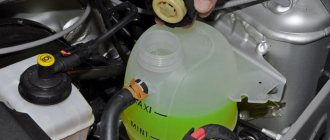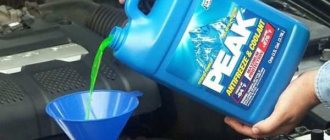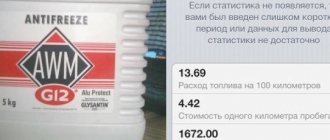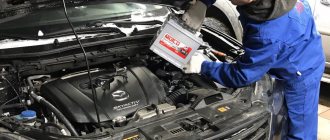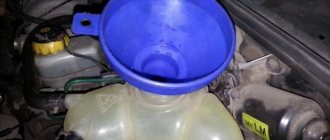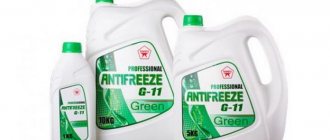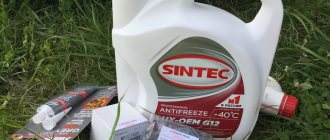Proper addition of coolant is the key to long and trouble-free operation of a passenger car engine. Its chemical composition affects the operating conditions of the cooling system and the condition of individual engine parts.
The level of technical fluids must be periodically monitored. If it falls, action should be taken. Adding antifreeze is easy. But it is important to understand what can be mixed with what, when and how often it should be done.
Where and how to fill antifreeze correctly
Why do you need antifreeze
Various types of antifreeze are available. Their properties also differ. All such liquids have in common that their boiling point is high and their freezing point is low.
The main purpose of antifreeze is to cool the car engine and equalize the temperature of its individual sections
Another function of coolant is to reduce the load on individual engine parts. It also prevents the spread of corrosion. These properties are determined by special additives and additives. The liquid is involved in heating the passenger compartment and the throttle body, because the stove is part of the cooling system.
If the volume of antifreeze is insufficient, the engine overheats, which can lead to a decrease in thermal clearances, accelerated wear, and possible jamming of connecting rod and piston parts. The result is a broken connecting rod and a major overhaul or replacement of the engine.
Basic rules for adding antifreeze
Let us remind you that mixing different refrigerants is unacceptable in most cases, since at the output the mixed cocktail may precipitate, which will not disappear on its own, but will begin to systematically coke the thin radiator tubes and other delicate parts of the cooling system. Therefore, it is worth filling only with fluids indicated for use, which have received the approval of the car manufacturer, and only adding the same component that fills the already existing SOD with its base.
The question of how antifreeze or antifreeze behaves when added to ordinary water can be left open. Concentrates of these substances give excellent performance with water in certain acceptable proportions, again if distilled water is poured in, and not a composition of chlorine, sodium, magnesium and potassium, which often comes out of the tap.
Again, we remind you that the color of the coolant does not affect its composition in any way - green, blue, and red liquids can be compatible with each other, while liquids of the same color, for example, yellow, can have completely different structures, additives and bases.
Choosing antifreeze for gravy
To determine which coolant needs to be filled, refer to the manual or reference literature provided by the car manufacturer. Typically, the manufacturer gives the user the right to choose, allowing the use of one of several options for technical fluids. It is recommended to add only the antifreeze that is already in the system.
It is allowed to mix funds of only one class. It is not the color of the liquid that will help you identify your classmates, since there is no single approach to ranking, but a special marking on the label.
Almost every country has its own standards for the quality of petroleum products. Manufacturers, in order to make things easier for car enthusiasts, adopted a unified classification, which was once developed by Volkswagen AG.
Coolant classes:
- G11 – possible marking Traditional or Convertional coolants, IAT (Inorganic Acid Technology). But there are packages without such signs at all;
- G12 - Carboxylate coolants or OAT (Organic Acid Technology);
- G13.
G11 is produced using traditional (silicate) technology. The composition includes various combinations of inorganic substances (amines, nitrates, silicates, phosphates, borates, nitrites).
In 2008, class G12 (G12+, G12++) appeared - these are carboxylate antifreezes made using silicate technology. Carboxylic acids are added to them as additives. G12+ is also labeled as Hybrid coolants or HOAT (Hybrid Organic Acid Technology).
G13, which entered the market in 2012, is made on the basis of propylene glycol, which is harmless and environmentally friendly. Technologically, this class is equivalent to G12++ and differs only in its environmental friendliness. G12+, G12++ and G13 are also labeled as Lobrid or SOAT coolants.
Most manufacturers adhere to this scheme for dividing coolant by color:
- G11 can be blue, green or blue-green;
- all G12 are red in any variations (from orange to purple);
- G13 is most often purple or pink, but other options are possible.
Compound
The answer to the question of how to add antifreeze contains several points. In order for coolant to be added correctly, you need to take into account the characteristics of your car. If you decide that it is time to update the amount of refrigerant in the cooling system, you need to pay special attention to the composition. All antifreezes are divided into categories or classes:
G11.
These are traditional liquids based on ethylene glycol, water and silicate additives. They have a completely inorganic composition, so they can only be mixed with each other. For these antifreezes, manufacturers usually choose colors such as blue, green and sometimes yellow.
G12.
These are coolants that are called organic or carboxylate. Their base is also ethylene glycol, but compositions with carboxylic acid are used as additives. Such substances can be combined with the same or with antifreezes, the labeling of which contains advantages. Most often, such liquids are painted in warm colors: red, purple, pink and orange.
G12 (with pluses).
These are hybrid compositions that contain both silicate additives and organic additives based on carboxylic acid. They are suitable for mixing with other liquids from this category or with refrigerants of the G12 category. By color you can most often find bright yellow, lilac, purple and scarlet antifreezes of this class.
G13.
These substances are known as lobrids because they are significantly different from other refrigerants. The composition of coolant belonging to this category is based on propylene glycol. Therefore, such compositions can only be mixed with each other. They are painted in lilac, pink and purple colors, but sometimes you can also find yellow G13 class antifreeze.
MULTIFREEZE.
This liquid is a unique product that can be mixed with representatives of any class. Its composition is compatible with both traditional inorganic and carboxylate antifreezes. Multifreeze is also suitable for adding to hybrid and lobride liquids.
Is it possible to add incompatible compounds to the cooling system? No, this will damage the car. If you do not know what kind of antifreeze was poured into the car at the factory, it is better to drain the remaining amount. This must be done so that the new product does not enter into an unpredictable chemical reaction with it.
What you need to know to avoid mistakes
Correctly mix liquids of the same class. The exception is adding G12+ antifreeze, which can be added to G11 and G12. If you do not adhere to this rule, an insoluble sediment may form, which will gradually clog the pipes and cause premature engine wear.
It is strictly forbidden to pour antifreeze into antifreeze, because they differ greatly in chemical composition.
The coolant is produced both in the form of a mixture, which can be poured immediately, without preliminary preparation, and in the form of a concentrate.
It is forbidden to take concentrated products for refilling, even if the classes of antifreeze are the same: first, the concentrate is diluted according to the instructions. Proportions are often determined by the planned operating temperature conditions.
What you need to know when adding antifreeze
It is worth recalling this important rule: you cannot mix refrigerants with different characteristics. When mixing such a cocktail, as a rule, a precipitate forms, which will not evaporate in the air and will not disappear, but will systematically settle on the thin radiator tubes and other parts of the SOD and coke in the delicate parts and mechanisms of the system. That is why manufacturers recommend the use of those antifreezes that are suitable for your car, and those that are approved and initially fill the car’s cooling system.
Many car enthusiasts wonder whether it is possible to add water to antifreeze? The question is quite interesting, in small quantities and observing the correct proportions, this method is possible, but provided that it is distilled water and not tap water with various impurities in the form of chlorine, sodium, potassium and other chemical elements.
You should not focus on the color of the coolant, it will only confuse you completely. The color of antifreeze does not depend on its quality and composition. Sometimes liquids of the same shade can be completely different in chemical composition, and vice versa, multi-colored antifreezes will be compatible in structure, additives, and base. Therefore, when purchasing, you should pay attention not to the color of the coolant, but to its composition and main characteristics.
Is it possible to add water to antifreeze?
To find out whether it is possible to dilute the coolant with water, you should study the composition of the antifreeze. Its base (about 90%) is ethylene glycol or propylene glycol. This is a dihydric alcohol, in its pure form it is an oily substance. The boiling point is +200°C. It freezes at -12.3°C.
There is water there too. Its share is 3-5%. Distillate is added during production. The remaining 5-7% comes from additives. It is they that distinguish all types of coolant; it is the additives that affect the duration and quality of engine service.
How often should the coolant be changed?
Generally accepted recommendations are at least once every 24 months. If you focus on the mileage of the car, then the solution should be drained after 30-45 thousand kilometers. Of course, when changing, you should take into account the condition of the vehicle, its total mileage, and the manufacturer’s recommendations. Silicate-based liquid can be used for up to three years, and hybrid substances retain their unique properties for up to five years. Carboxylate solutions can be used for more than five years and are designed for a mileage of 100 thousand km.
Like any other product, it has its own expiration date, recommendations for storage and use. If storage conditions are violated, it ceases to perform its assigned functions before the date indicated on the label, so it is necessary to constantly monitor its condition.
Methods that help determine when you need to change the antifreeze in your car:
Test strip. This method for determining the condition of an auto fluid is recommended by leading manufacturers. Test strips are sold in all specialized auto stores. The strip should be immersed in a container, after which it acquires a certain shade. The design comes with a color scale so you can easily determine when replacement is needed.
Refrigerant consistency. This method is often used for antifreeze, the optimal density is 1.078 g/cm3. at a temperature of 20 degrees. The waste material has different density indicators.
Color. A suitable coolant has a bright, rich color, which fades and becomes cloudier during use. If the substance is red or tan in color, this indicates the presence of rust and must be replaced urgently.
Presence of foreign substances in the solution. Foam, flakes, chips, and sediment may form in the used product, which indicates its unsuitability for further use.
The above methods will help determine the replacement period in time in order to maintain the working condition of the power unit, prevent serious damage and avoid costly repairs.
It is allowed to add water to antifreeze, but with certain restrictions
It should be distilled, although you can also add just well-purified, filtered water. The absence of impurities will eliminate the possibility of starting a chemical reaction with additives and additives contained in antifreeze. Also, clean water is a guarantee that the system will not become clogged. It is correct to add no more than 100-200 ml. If you take more, the proportion of additives will change, and the performance properties of the composition will change.
At the same time, the volume of coolant often decreases due to water evaporation. Losses occur when the safety valve on the expansion tank opens. Ethylene glycols are the last to evaporate. Adding water may simply be necessary to restore the original composition of the antifreeze. But in winter you need to be very careful when diluting technical fluids.
Checking the tightness of the plug and tank
Stirring and constant movement can cause corrosion of the valve due to constant contact with the liquid. To avoid leaks, it is necessary to regularly check its condition. In addition to topping up, the plug should only be checked after the engine has completely cooled down. The valve is inspected and screwed back on. If it does not turn properly, it should be replaced.
You can check the tightness of the container using the holder. This is usually done at gas stations, but if you wish, you can arrange such a check yourself. The tank is carefully removed from the car. It has three holes. Two of them have shock absorption, and the rest are powered by air from a tire inflation pump. The test plug must be screwed in tightly. If, when creating high pressure inside the tank, the valve allows air to pass through, it must be urgently replaced.
If the valve maintains a pressure of 1.3 to 2 atmospheres, it also does not work. The optimal indicator of a good condition of the plug is when, at a pressure of 1.4 atmospheres or more, it opens and releases excess pressure.
After turning off the pump, it is necessary to maintain pressure in the tank - this ensures that the tank is in good condition and ready for further use.
When to add antifreeze
How often to add antifreeze is determined taking into account several markers. Visual inspection of the technical fluid is carried out periodically. On expansion tanks there are marks with the symbols L (low - low) and F (full - full) or Min (minimum) and Max (maximum).
If the level is below the first mark, add antifreeze. On some car models there is a special icon on the dashboard, the inclusion of which indicates a low fluid level in the cooling system.
Coolant replacement
The coolant must be replaced if it has worked within the prescribed period, and also if the car has undergone maintenance after active use in summer or winter.
To properly charge antifreeze into the cooling system, it is recommended to first completely remove the old liquid, including from the heating system, by setting the heater regulator to maximum. Placing the vehicle on the slope with the front facing up will help make the process more efficient. Next you need to open the expansion tank and radiator cap. Then unscrew the plugs on the cylinder block and radiator and drain the coolant.
If the old coolant has performed its function correctly, it is still worth adding. Before doing this, it is recommended to flush the cooling system with water, preferably distilled water, by forcing the engine to pump it through all pipes and radiators, heating it to a temperature at which the valve injects fluid into the larger circulation.
If the coolant is heavily contaminated, for example, after using sealants, plain water, or mixing antifreeze with radically different flushing compositions, it will be necessary to use a special detergent, after which the system must be flushed with distilled water. After this, you can add new antifreeze to the system.
Excess air can be removed after adding coolant by venting it through a tube at the top of the cylinder block. If necessary, the expansion tank is additionally filled with antifreeze to the normal level.
Flushing the system
The cooling system should not be flushed frequently - once a year or when signs appear indicating the need to replace the antifreeze.
If it is necessary to add coolant in a volume of about 30% of the technological minimum, then it should be completely replaced.
If the check shows that the antifreeze has turned black or become thicker, it is changed. Replacement is also carried out when:
- regular engine overheating;
- the end of the service life of the poured composition;
- supply of cold air from the stove;
- early operation of the fan and its operation at high speeds;
- unsatisfactory functioning of the pump;
- when the safety release valve on the expansion tank is activated.
Acid-containing compounds are used to remove rust, and alkaline compounds are used to combat alkaline deposits. Work should be carried out correctly in warm weather. Draining is carried out through a special hole. Residues are removed through an additional outlet, which is located on the bottom and is often covered with a protective panel.
What you can fill in to flush the system:
- water;
- citric acid;
- acetic acid;
- lactic acid;
- caustic soda;
- special equipment (LAVR, LIQUI MOLY Kuhler-Reiniger, Hi-Gear Radiator Flush-7 minute).
Acids are usually pre-diluted with water. The technology of work depends on the type of product chosen.
Consequences of lack of auto fluid in the system
With the right choice and timely updating, you can avoid serious problems with your vehicle:
The occurrence of corrosion that damages parts made of metal. The corrosive layer disrupts the heat exchange process and reduces the rate of coolant circulation.
Engine overheating, which significantly increases fuel consumption and reduces the power of the power unit.
Sediment from silicate products leading to engine overheating.
Formation of chips and cracks. Often the solution is diluted with water, wanting to save on the purchase of an expensive product. Not all manufacturers allow dilution, since when the temperature changes, the diluted substance freezes and can damage the tank.
How to add antifreeze correctly
Adding antifreeze begins with monitoring the condition of the cooling system. If the liquid leaves, it is necessary to exclude mechanical damage to the expansion tank body, pipes, radiators, joints and other things. The fact that the problem is in the equipment is indicated by the fact that the antifreeze leaves too quickly.
Level control is carried out with the machine installed on a flat horizontal surface. To avoid burns, work is carried out on a cold engine.
The first rule on how to properly add antifreeze is to find the entrance to the cooling system and clearly identify its filler neck. The variety of technical solutions for arranging the engine compartment can confuse an inexperienced car enthusiast. Some people confuse the cooling system and the washer reservoir. On the neck of the latter there is a special image: a fan-shaped fountain against the background of the windshield. Also, do not pour antifreeze into the radiator hose.
Why should you add coolant?
Antifreeze is the common name for special engine coolants. During operation, they circulate through a special circuit, which allows the generated heat to be removed. The heated antifreeze is transferred to the radiator, where it is rapidly cooled. If there is not enough process fluid or its quality is lost, then the temperature of the power unit will rapidly exceed the limit level. An overheated engine wears out quickly and may stall or even seize.
How to add antifreeze: step-by-step instructions
How to add antifreeze correctly:
- you need to install the car on a slope. The hood should be higher than the trunk. Then it will be easier for the air displaced by the liquid to exit the system. If the amount of additive is small, you can leave the car in a horizontal position;
- slowly and carefully open the expansion tank cap. It is advisable to wear gloves on your hands. The neck is first covered with a rag. This is necessary so that, if the system is under pressure, it does not damage clothing and skin;
- antifreeze is supplied to the car. The product is poured slowly, in a thin stream, since a large volume of liquid can lead to the formation of an air lock. It will be difficult to get rid of it;
- start the engine. He needs 3-5 minutes. During this time, the antifreeze will be distributed throughout the system;
- as a result, the level may decrease slightly. Then you should add a little more product. Then they start the car again. Let it run for another 3-5 minutes and check the level in the system again. The cycle must be repeated until the required volume becomes stable;
- properly complete any cleaning work - use a rag to remove splashes from the neck and surrounding areas to avoid damage;
- screw the lid on.
How to add coolant: it should occupy approximately 2/3 of the volume of the expansion tank. The level should be close to F (full) or Max.
To remove air from the system, use a valve (screw) located on the cylinder block of the internal combustion engine. They open it and wait for the first drops to appear. After this, the tap is tightened tightly.
The canister - with or without residue - is worth saving, as it will be easier to add antifreeze again, knowing what has already been used. An alternative option is to keep a vehicle logbook and record information about maintenance and repairs performed in it.
Typical mistakes when adding coolant
It is necessary to replenish the refrigerant level in the system not only on time, but also correctly. In their manuals, car manufacturers describe in detail all the details of the procedure. There are always recommendations on the packaging of any antifreeze. But to many motorists the process itself seems simple, so no one delves into the technical documentation. So that you can avoid common mistakes, we have prepared a rating of them.
1. Constant rush
Automotive and coolant manufacturers emphasize in bold letters, warnings, and exclamation marks the strict need to add antifreeze to a “cold” system. At a minimum, the car should stand with the engine turned off for at least 10 minutes. What are the consequences of a violation? First of all, it is dangerous.
it is important! When adding cold liquid to hot liquid, a characteristic bubbling begins. As a result, the hasty motorist gets burns on his hands and greasy stains in the engine compartment. But there is also a technical aspect. The heated liquid occupies the maximum volume, so you will only need to add a little. As it cools, the antifreeze level will drop, but you won’t notice it.
2. Adding water
The chemical composition of automotive coolant is calculated based on the standard water content - approximately 5%. At this concentration, all anti-corrosion, anti-foam and other performance properties of the product are preserved. If you simply add water, then it is no longer possible to guarantee any properties of the entire liquid. Such actions often lead to freezing, which ultimately damages the line and radiator. Adding water is allowed only in emergency situations, when you need to raise the coolant level, but there is nowhere to get a suitable composition. Immediately after an abnormal dilution of antifreeze, you need to go to a service station to flush the system and fill it with good refrigerant.
3. Sudden movements
This error is also related to security issues. It lies in the fact that some motorists sharply unscrew the filler cap. If the machine has recently been operated, such actions may result in the release of a large volume of hot steam. To protect yourself from burns, you need to act carefully and slowly.
4. The details were mixed up
Some motorists, especially those who have never encountered the problem of adding antifreeze, want to add it directly to the radiator. This can only be done with some car models; for others it is better to use an expansion tank. If the radiator design of your car is collapsible, you can add coolant there. But this will make it more difficult to determine its level in the system and prevent the occurrence of air locks.
5. More is not better
There is no need to confuse antifreeze and engine oil. If the latter needs to be filled to the limit, then it is better to stop the coolant level in the middle of the expansion tank. If there is an excess of liquid, its thermal expansion will lead to increased pressure in the system. At best, this will result in a cracked tank, but you may also encounter ruptures in the system.
6. Matching by color
Adding antifreeze according to rules like “red to red” or “blue to blue” is a gross mistake. In fact, no one regulates the color schemes of manufacturers. The choice of coolant should be based on its chemical composition.
Recommendations from manufacturers
Manufacturers always indicate the recommended period for using the liquid on the label. At the end of the specified period, it should be changed, since its unique properties are lost.
How often should you change the antifreeze in your car? Replacement intervals depend on the manufacturing technology of the product and its standard. Automotive industry giant Volkswagen proposed its own classification, which was picked up and actively used by other companies:
G11 (green) - traditional solutions that consist of inorganic silicate compounds and other synthetic elements. The advantage of this class of products is the formation of a special protective layer on engine parts, which prevents the development of corrosion. When using a technical solution longer than the prescribed period, the protective layer precipitates, the level of protection deteriorates, and flakes clog system components. The update interval recommended by the manufacturer is 24 months. Antifreeze has similar qualities, so the recommended period of use is also 2 years.
G12 (red/orange) - standard designating coolants for the manufacture of which organic acids were used. It differs from the traditional type in its heat transfer properties and targeted effect on the source of corrosion, preventing its spread. After the expiration of the permissible service life, the substance loses its properties too quickly, so they must be drained every 5 years.
G13 (yellow) – new generation of (lobrid) coolants. The main element of this class of solution is propylene glycol - an environmentally friendly and reliable component. According to the principle of operation, antifreezes of this class are similar to the G12 standard. Replacements in a car are carried out every 5-10 years, but some popular companies claim that their product does not lose its properties throughout the entire life of the cooling system.
Which antifreeze to choose for your car
Choosing the right antifreeze is not an easy task; there is quite a large supply of them on the modern market. To make the right choice, you will need to initially decide what type of product will be used, antifreeze or antifreeze.
Most car enthusiasts prefer antifreeze as a higher quality and modern product.
Antifreezes have special characteristics:
- have a beneficial effect on the operation of the vehicle’s propulsion system
- extend its life
- allow you to operate the car in extreme conditions
- increase engine performance
- maintain performance characteristics over a wide temperature range
Antifreeze is supplied to the retail chain in the form of:
- ready-to-use solution
- concentrate, which will need to be dissolved in distilled water.
The performance characteristics of both liquids will be the same, but the concentrate is more convenient to store, because its volume is much smaller.
Watch a video about different types of antifreeze and their features:
Recommendations for using coolant on used cars
Engines on used cars in most cases are not in perfect technical condition. Often, the expiration date of consumables on such machines differs significantly from the recommendations for new vehicles.
How often should antifreeze be changed in a high mileage car? It is impossible to name the exact time period for using coolant. It is necessary to independently monitor the condition of the antifreeze using one of the methods suggested above. Antifreeze should be changed immediately if it has been diluted with water or a substance from another manufacturer.
